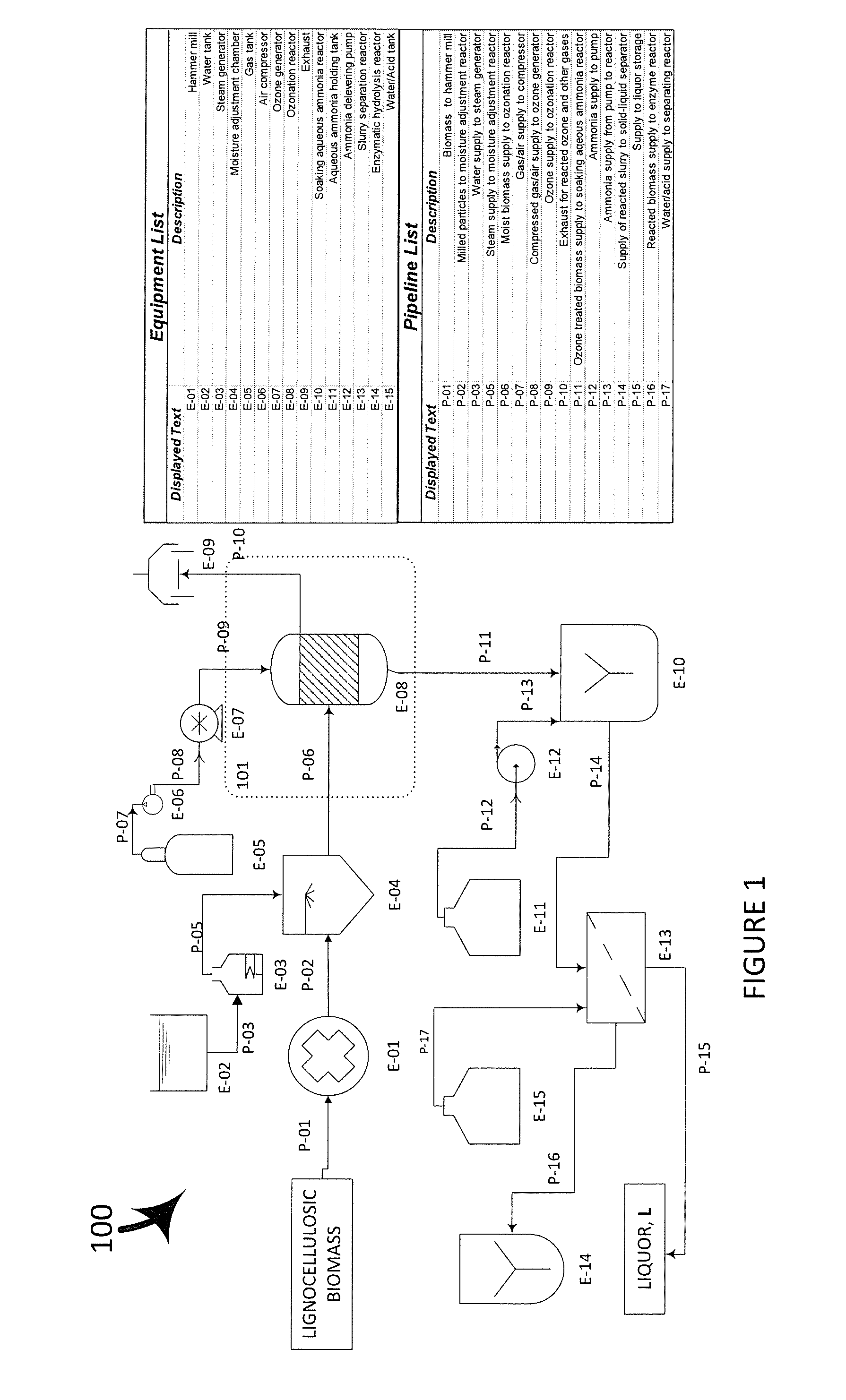Advanced Methods for Sugar Production from Lignocellulosic Biomass and Fermenting Sugars to Microbial Lipids
a technology of lignocellulosic biomass and fermentation sugar, which is applied in the direction of fuel, pulp liquor regeneration, pretreatment with oxygen-generating compounds, etc., can solve the problems of poor carbohydrate recovery, pretreatment methods, and inhibition of subsequent downstream processes such as saccharification, so as to increase the cellulose microfibril structure, easy hydrolysis, and easy to hydrolyz
- Summary
- Abstract
- Description
- Claims
- Application Information
AI Technical Summary
Benefits of technology
Problems solved by technology
Method used
Image
Examples
example 1
Sugar Analysis of Control, Ozone Treated, Soaking Aqueous Ammonia (SAA) Treated, and Combined (Ozone Followed by SAA Treated Hence Forward OSAA) Wheat Straw
[0112]The sugar analysis of control, ozone treated sample for 2 hour (conditions: (ozonation: 90% moisture adjustment of 42-60 mesh particles, 2 hour reaction time with 5.4% ozone in 2 L / minute oxygen gas flow rate), only SAA treated (conditions 60° C. and 24 hours), OSAA treated (ozonation: 90% moisture adjustment of 42-60 mesh particles, 10 min reaction time with 5.4% ozone in 2 L / minute oxygen gas flow rate; SAA: 20% solid loading (w / v), 20% ammonium hydroxide in water (w / v), 50° C. reaction temperature and 6 hours residence time) of wheat straw samples are shown in Table 1. The concentration of monosaccharide for ozone treated samples decreased minutely, which could be reaction of ozone with sugars. The representative sugar concentration of SAA and OSAA treated samples increased significantly when measured on percentage basis...
example 2
Effect of Pretreating Wheat Straw Particles with Ozone Alone on Sugar Recovery
[0113]Wheat straw particles (42-60 mesh size) were adjusted with 90% (w / w) moisture content and treated with stream of ozone-enriched oxygen gas containing 5.4% ozone (oxygen flow rate 2 L / min) at room temperature (23° C.) in stainless steel reactor for 5 to 30 min. The treated biomass was removed and saccharified according to the following procedure. The wheat straw residue from the above procedure (0.2 g) was added to 20 ml citrate buffer (pH=4.8), Celluclas® 1.5 L (71.0 μL, protein concentration=126.5 mg / mL) and Novozym 188 (14.0 μL, protein concentration=134 mg / mL) enzyme mixture, and the mixture was left stirring in an incubator shaker at 50° C. Samples were removed after 72 hours, enzyme was deactivated by boiling for 5 min and sugar concentration was analyzed by DIONEX-ion chromatography. Results are shown in Table 2. The results showed that pretreating wheat straw particles with ozone increases sug...
example 3
Effect of Peroxone Treatment on Enzymatic Hydrolysis of Wheat Straw Particles
[0114]Wheat straw particles (42-60 mesh size) 3 g were thoroughly mixed with water containing H2O2 (concentration was adjusted to deliver 1:2 molar ratio of H2O2 to ozone) to adjust 90% (w / w) moisture content. This mixture was placed in stainless steel reactor and treated with stream of ozone-enriched oxygen gas containing 5.4% ozone (oxygen flow rate 2 L / min) to generate highly reacting hydroxyl radical at room temperature (23° C.) for 5 to 30 min. The treated biomass was removed and saccharified according to the following procedure. The wheat straw residue from the above procedure (0.2 g) was added to 20 ml citrate buffer (pH=4.8), Celluclast® 1.5 L (71.0 μL, protein concentration=126.5 mg / mL) and Novozym 188 (14.0 μL, protein concentration=134 mg / mL) enzyme mixture, and the mixture was left stirring in an incubator shaker at 50° C. Samples were removed after 72 hours, enzyme was deactivated by boiling fo...
PUM
| Property | Measurement | Unit |
|---|---|---|
| temperature | aaaaa | aaaaa |
| pressure | aaaaa | aaaaa |
| temperature | aaaaa | aaaaa |
Abstract
Description
Claims
Application Information
 Login to View More
Login to View More - R&D
- Intellectual Property
- Life Sciences
- Materials
- Tech Scout
- Unparalleled Data Quality
- Higher Quality Content
- 60% Fewer Hallucinations
Browse by: Latest US Patents, China's latest patents, Technical Efficacy Thesaurus, Application Domain, Technology Topic, Popular Technical Reports.
© 2025 PatSnap. All rights reserved.Legal|Privacy policy|Modern Slavery Act Transparency Statement|Sitemap|About US| Contact US: help@patsnap.com



